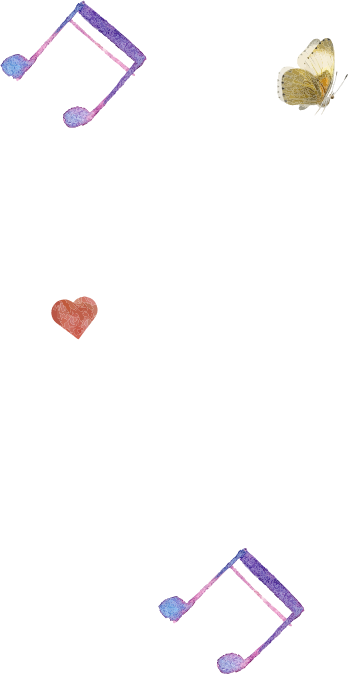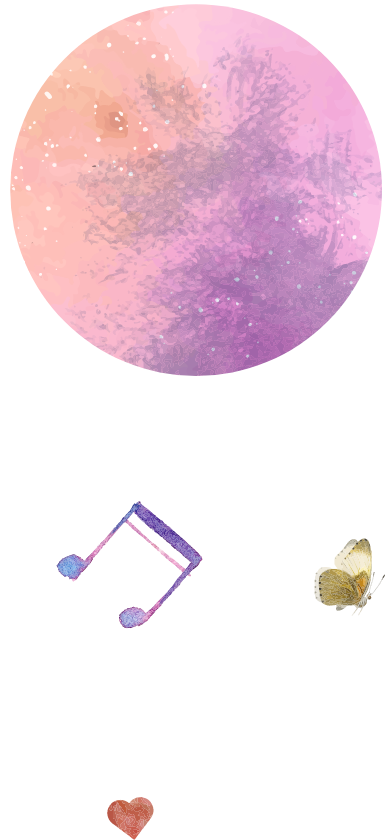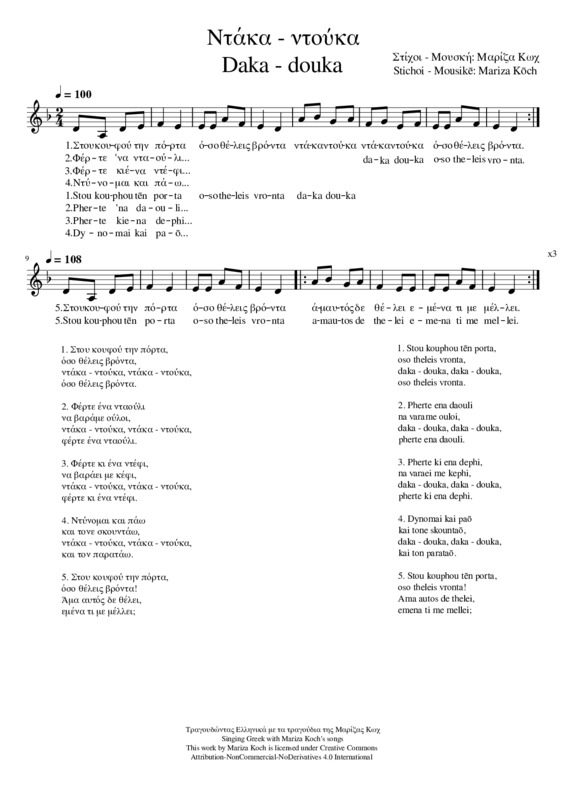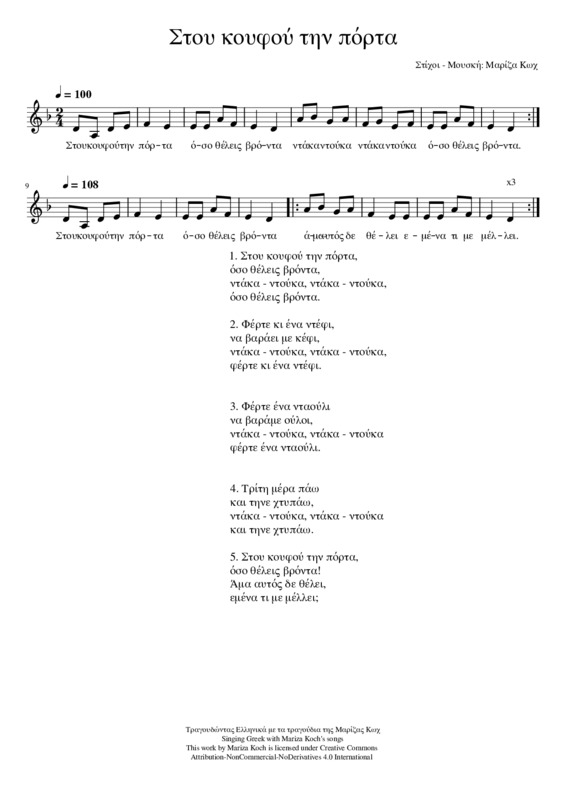
Stou kouphou tēn porta

Stou kouphou tēn porta
Pronunciation
Articulation of the double consonant /ντ/ (nt or d) and the phoneme /φ/ (ph) and their use in the Greek language [ντάκα-ντούκα (daka-douka), κουφού (kouphou), φέρτε (pherte), φάμε (phame), etc.].
Games with the echomimetic words “ντάκα-ντούκα (daka-douka), ντράγκα-ντρούγκα (ntranka-ntrounka), ντρίκι-ντράγκα (driki-dranka), ντούρου-ντούρου (dourou-dourou), φράπα-φρούπα (phrapa-phroupa), etc.
Games with the echomimetic words “ντάκα-ντούκα (daka-douka), ντράγκα-ντρούγκα (ntranka-ntrounka), ντρίκι-ντράγκα (driki-dranka), ντούρου-ντούρου (dourou-dourou), φράπα-φρούπα (phrapa-phroupa), etc.
Speech Comprehension and Production
Rhyme: cross rhyme e.g. ντέφι-κέφι (dephi-kephi), νταούλι-ούλι (daouli-ouli), πόρτα-βρόντα (porta-vronta), and holo-rhyme e.g. κέφι-ντέφι (kephi-ntephi), ούλοι-νταούλι (ouloi-daouli), χτυπάω-παρατάω (chtypaō-parataō).
Vocabulary: Greek traditional musical instruments. Create verses with other traditional instruments following the rhyme and the rhythm of the song (clarinet, violin, lute, etc.).
Proverb: “Στου κουφού την πόρτα, όσο θέλεις βρόντα” (stou kouphou tēn porta, oso theleis vronta, you cannot teach an old dog new tricks). Familiarization with Greek proverbs.
The phrase: “Αν αυτός δε θέλει, εμένα τι με μέλλει;” (an aytos de thelei, emena ti me mellei?) as a pattern found in folk songs and rempetika.
Familiarization with the rule of three in the folk tradition [μια του κλέφτη, δυο του κλέφτη, τρεις και τον τσακώσαμε (mia tou klephtē, dyo tou klephtē, treis kai ton tsakōsame)/ τρία πουλάκια κάθονταν, το ένα κοιτάει..., το άλλο κοιτάει...., το τρίτο ... (tria poulakia kathontan, to ena koitaei…, to allo koitaei…, to trito…)]. The element of repetition in the lyrics of the song according to the rule of three, the first day I go with a tambourine, the second day with a drum, and the third day I go and hit it.
Vocabulary: Greek traditional musical instruments. Create verses with other traditional instruments following the rhyme and the rhythm of the song (clarinet, violin, lute, etc.).
Proverb: “Στου κουφού την πόρτα, όσο θέλεις βρόντα” (stou kouphou tēn porta, oso theleis vronta, you cannot teach an old dog new tricks). Familiarization with Greek proverbs.
The phrase: “Αν αυτός δε θέλει, εμένα τι με μέλλει;” (an aytos de thelei, emena ti me mellei?) as a pattern found in folk songs and rempetika.
Familiarization with the rule of three in the folk tradition [μια του κλέφτη, δυο του κλέφτη, τρεις και τον τσακώσαμε (mia tou klephtē, dyo tou klephtē, treis kai ton tsakōsame)/ τρία πουλάκια κάθονταν, το ένα κοιτάει..., το άλλο κοιτάει...., το τρίτο ... (tria poulakia kathontan, to ena koitaei…, to allo koitaei…, to trito…)]. The element of repetition in the lyrics of the song according to the rule of three, the first day I go with a tambourine, the second day with a drum, and the third day I go and hit it.
Music Activities
The pupils sing and walk to the rhythm of the meter. Use of non-pitched percussion instruments, performing of the “daka-douka” pattern successively by all the pupils.
Create rhythmic and melodic patterns for the phrase "daka-duka, daka-duka" with body percussion voice, or melodic instruments.
Modify the music text and practice it through the song: create dashes, use pauses, change the rhythmic values, create a new melody.
Familiarization with the instruments mentioned in the song: door, tambourine, drum. Performing on the spot or listening to audio recordings and recognition of the instrument by the pupils. Listen to songs from different regions of the Hellenic world that contain these instruments.
Song of the first and last verse as a rule.
Sound recognition game by following predetermined instructions with closed eyes, such as tambourine-left, davul-right, door-front, bells or zill-turn on the spot.
Games with closed eyes: e.g. three pupils sit with their eyes closed, another pupil hits objects in the classroom and the pupils with their eyes closed have to find them.
Internal listening game: pupils wear earplugs and try to chew on different foods that make different sounds (peanuts, carrots, cucumbers, bread, etc.) and then discuss their own listening experiences and any correlations they have made.
Create rhythmic and melodic patterns for the phrase "daka-duka, daka-duka" with body percussion voice, or melodic instruments.
Modify the music text and practice it through the song: create dashes, use pauses, change the rhythmic values, create a new melody.
Familiarization with the instruments mentioned in the song: door, tambourine, drum. Performing on the spot or listening to audio recordings and recognition of the instrument by the pupils. Listen to songs from different regions of the Hellenic world that contain these instruments.
Song of the first and last verse as a rule.
Sound recognition game by following predetermined instructions with closed eyes, such as tambourine-left, davul-right, door-front, bells or zill-turn on the spot.
Games with closed eyes: e.g. three pupils sit with their eyes closed, another pupil hits objects in the classroom and the pupils with their eyes closed have to find them.
Internal listening game: pupils wear earplugs and try to chew on different foods that make different sounds (peanuts, carrots, cucumbers, bread, etc.) and then discuss their own listening experiences and any correlations they have made.
Cross-thematic Connections - Greek Culture
Interdisciplinary concepts: communication, individual-group.
Watch videotaped excerpts with songs that are also rendered in sign language. Study the sign language and render the song in it.
Familiarization with other proverbs of the Greek language.
Discussion on the deaf and hard of hearing, the difficulties they face, ideas on how pupils could help in the smooth integration of a prospective deaf classmate. Community awareness actions: Discuss how the students could raise public awareness for the hard of hearing.
Watch videotaped excerpts with songs that are also rendered in sign language. Study the sign language and render the song in it.
Familiarization with other proverbs of the Greek language.
Discussion on the deaf and hard of hearing, the difficulties they face, ideas on how pupils could help in the smooth integration of a prospective deaf classmate. Community awareness actions: Discuss how the students could raise public awareness for the hard of hearing.
Age level
3-7 years old
7-11 years old
Language level
Beginner
Music
Unpublished





